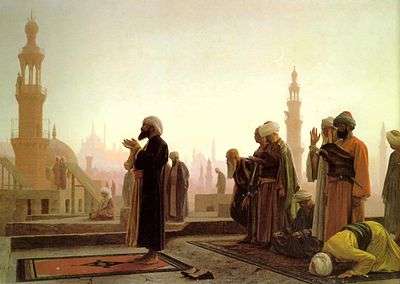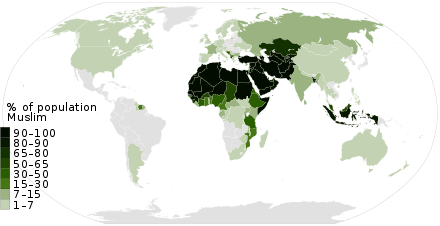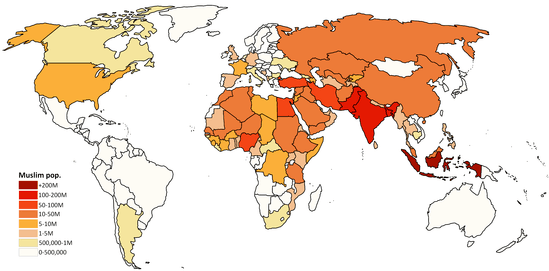Muslim
 Muslims praying in 1865 Cairo by Jean-Léon Gérôme | |
| Total population | |
|---|---|
| 1.8 billion worldwide (2015 est.)[1][2][3] | |
| Founder | |
| Muhammad[4] | |
| Regions with significant populations | |
| 227,226,404[5] | |
| 197,547,566[6] | |
| 189,000,000[7] | |
| 148,607,000[8] | |
| 95,316,131[9] | |
| 87,336,965[10] | |
| 81,529,435[11] | |
| 80,683,525[12] | |
| 50,000,000[13] | |
| 40,559,749[14] | |
| 38,800,190[15] | |
| 35,713,657[16] | |
| 34,022,437[17] | |
| 33,646,788[18] | |
| 30,490,000[2] | |
| 27,784,498[19] | |
| 27,143,182[20] | |
| 26,550,000[2] | |
| 19,237,161[21] | |
| 18,930,000[2] | |
| Rest of the world | 287,230,000[2] |
| Religions | |
|
65–75% Sunni Islam[22][note 1] | |
| Scriptures | |
| Quran[25] | |
| Languages | |
| |
| Part of a series on |
| Islam |
|---|
 |
|
A Muslim (Arabic: مُسلِم) is someone who follows or practices Islam, a monotheistic Abrahamic religion. Muslims consider the Quran, their holy book, to be the verbatim word of God as revealed to the Islamic prophet and messenger Muhammad. The majority of Muslims also follow the teachings and practices of Muhammad (sunnah) as recorded in traditional accounts (hadith).[28] "Muslim" is an Arabic word meaning "submitter" (to God).[29]
The beliefs of Muslims include: that God (Arabic: الله Allāh) is eternal, transcendent and absolutely one (tawhid); that God is incomparable, self-sustaining and neither begets nor was begotten; that Islam is the complete and universal version of a primordial faith that has been revealed before through many prophets including Abraham, Ishmael, Isaac, Moses, and Jesus;[30] that these previous messages and revelations have been partially changed or corrupted over time (tahrif)[31] and that the Qur'an is the final unaltered revelation from God (Final Testament).[32]
Qualifier
The religious practices of Muslims are enumerated in the Five Pillars of Islam: the declaration of faith (shahadah), daily prayers (salat), fasting during the month of Ramadan (sawm), almsgiving (zakat), and the pilgrimage to Mecca (hajj) at least once in a lifetime.[33][34]
To become a Muslim and to convert to Islam is essential to utter the Shahada, one of the Five Pillars of Islam, a declaration of faith and trust that professes that there is only one God (Allah) and that Muhammad is God's messenger.[35] It is a set statement normally recited in Arabic: lā ʾilāha ʾillā-llāhu muḥammadun rasūlu-llāh (لَا إِلٰهَ إِلَّا الله مُحَمَّدٌ رَسُولُ الله) "There is no god but Allah, (and) Muhammad is the messenger of God."[36]
In Sunni Islam, the shahada has two parts: la ilaha illa'llah (there is no god but God), and Muhammadun rasul Allah (Muhammad is the messenger of God),[37] which are sometimes referred to as the first shahada and the second shahada.[38] The first statement of the shahada is also known as the tahlīl.[39]
In Shia Islam, the shahada also has a third part, a phrase concerning Ali, the first Shia Imam and the fourth Rashid caliph of Sunni Islam: وعليٌ وليُّ الله (wa ʿalīyyun walīyyu-llāh), which translates to "Ali is the wali of God.[40]
Lexicology
The word muslim (Arabic: مسلم, IPA: [ˈmʊslɪm]; English: /ˈmʌzlɪm/, /ˈmʊzlɪm/, /ˈmʊslɪm/ or moslem /ˈmɒzləm/, /ˈmɒsləm/[41]) is the active participle of the same verb of which islām is a verbal noun, based on the triliteral S-L-M "to be whole, intact".[42][43] A female adherent is a muslima (Arabic: مسلمة) (also transliterated as "Muslimah"[44] ). The plural form in Arabic is muslimūn (مسلمون) or muslimīn (مسلمين), and its feminine equivalent is muslimāt (مسلمات). The Arabic form muslimun is the stem IV participle[note 2] of the triliteral S-L-M.
The ordinary word in English is "Muslim". It is sometimes transliterated as "Moslem", which is an older spelling. The word Mosalman (Persian: مسلمان, alternatively Mussalman) is a common equivalent for Muslim used in Central and South Asia. Until at least the mid-1960s, many English-language writers used the term Mohammedans or Mahometans.[45] Although such terms were not necessarily intended to be pejorative, Muslims argue that the terms are offensive because they allegedly imply that Muslims worship Muhammad rather than God.[46] Other obsolete terms include Muslimite[47] and Muslimist.[48]
Musulmán/Mosalmán (Persian: مسلمان) is a synonym for Muslim and is modified from Arabic. It is the origin of the Spanish word musulmán, the (dated) German Muselmann, the French word musulman, the Polish words muzułmanin and muzułmański, the Portuguese word muçulmano, the Italian word mussulmano or musulmano, the Romanian word musulman and the Greek word μουσουλμάνος (all used for a Muslim).[49] In English it was sometimes spelled Mussulman and has become archaic in usage.
Apart from Persian, Spanish, Polish, Portuguese, Italian, and Greek, the term could be found, with obvious local differences, in Armenian, Dari, Pashto, Urdu, Hindi, Bengali, Marathi, Panjabi, Turkish, Kazakh, Uzbek, Kyrgyz, Azeri, Maltese, Hungarian, Czech, Bosnian, Bulgarian, Russian, Serbian, Ukrainian, Romanian, Dutch, and Sanskrit.
Meaning
The Muslim philosopher Ibn Arabi said:
A Muslim is a person who has dedicated his worship exclusively to God...Islam means making one's religion and faith God's alone.[50]
Other prophets
The Qur'an describes many prophets and messengers within Judaism and Christianity, and their respective followers, as Muslim: Adam, Noah, Abraham, Ishmael, Jacob, Moses, and Jesus and his apostles are all considered to be Muslims in the Qur'an. The Qur'an states that these men were Muslims because they submitted to God, preached His message and upheld His values, which included praying, charity, fasting and pilgrimage. Thus, in Surah 3:52 of the Qur'an, Jesus' disciples tell him, "We believe in God; and you be our witness that we are Muslims (wa-shahad be anna muslimūn)." In Muslim belief, before the Qur'an, God had given the Tawrat (Torah) to Moses, the Zabur (Psalms) to David and the Injil (Gospel) to Jesus, who are all considered important Muslim prophets.
Demographics


The most populous Muslim-majority country is Indonesia, home to 12.7% of the world's Muslims,[22] followed by Pakistan (11.0%), Bangladesh (9.2%), and Egypt (4.9%).[51] About 20% of the world's Muslims lives in the Middle East and North Africa.[22][52]
Sizable minorities are also found in India, China, Russia, Ethiopia, the Americas, Australia and parts of Europe. The country with the highest proportion of self-described Muslims as a proportion of its total population is Morocco.[2] Converts and immigrant communities are found in almost every part of the world.
Over 75–90% of Muslims are Sunni.[53][54] The second and third largest sects, Shia and Ahmadiyya, make up 10–20%,[55][56] and 1%[24] respectively.
With about 1.6 billion followers, almost a quarter of earth's population,[57][22][58] Islam is the second-largest and the fastest-growing religion in the world.[59] due primarily to the young age and high fertility rate of Muslims,[60] with Muslim having a rate of (3.1) compared to the world average of (2.5). According to the same study, religious switching has no impact on Muslim population, since the number of people who embrace Islam and those who leave Islam are roughly equal.[60]
A Pew Center study in 2016 found that Muslims have the highest number of adherents under the age of 15 (or 34% of the total Muslim population) of any major religion, while only 7% are aged 60+ (the smallest percentage of any major religion). According to the same study, Muslims have the highest fertility rates (3.1) of any major religious group.[61] The study also found that Muslims have the lowest average levels of education after Hindus, with an average of 5.6 years of schooling.[61] About 36% of all Muslims have no formal schooling,[61] and Muslims have the lowest average levels of higher education of any major religious group, with only 8% having graduate and post-graduate degrees.[61]
See also
Notes
References
- ↑ Lipka, Michael; Hackett, Conrad (6 April 2017). "Why Muslims are the world's fastest-growing religious group". pewresearch.org. Archived from the original on 23 August 2017. Retrieved 23 August 2017.
- 1 2 3 4 5 6 "The Future of World Religions: Population Growth Projections, 2010–2050". Pew Research Center. 2 April 2015. Archived from the original on 22 February 2017. Retrieved 22 February 2017.
- ↑ "Muslim Population by Country". The Future of the Global Muslim Population. Pew Research Center. Archived from the original on 9 February 2011. Retrieved 22 December 2011.
- ↑ Alford T. Welch, Ahmad S. Moussalli, Gordon D. Newby (2009). "Muḥammad". In John L. Esposito. The Oxford Encyclopedia of the Islamic World. Oxford: Oxford University Press.
The Prophet of Islam was a religious, political, and social reformer who gave rise to one of the great civilizations of the world. From a modern, historical perspective, Muḥammad was the founder of Islam. From the perspective of the Islamic faith, he was God's Messenger (rasūl Allāh), called to be a “warner,” first to the Arabs and then to all humankind.
- ↑ "The World Factbook — Central Intelligence Agency". www.cia.gov. Archived from the original on 10 December 2008. Retrieved 24 May 2017.
- ↑ "The World Factbook — Central Intelligence Agency". www.cia.gov. Archived from the original on 3 July 2015. Retrieved 5 November 2017.
- ↑ "Muslim Population in India - Muslims in Indian States". www.indiaonlinepages.com. Archived from the original on 8 September 2017. Retrieved 4 October 2017.
- ↑ "The Future of the Global Muslim Population". Pew Research Center's Religion & Public Life Project. 15 January 2011. Archived from the original on 24 May 2017. Retrieved 24 May 2017.
- ↑ "The World Factbook". Archived from the original on 2 May 2009. Retrieved 31 December 2017.
- ↑ "The World Factbook". Archived from the original on 11 June 2008. Retrieved 31 December 2017.
- ↑ "The World Factbook". Archived from the original on 19 November 2012. Retrieved 31 December 2017.
- ↑ "The World Factbook". Archived from the original on 20 September 2017. Retrieved 31 December 2017.
- ↑ United Nations High Commissioner for Refugees. "Refworld - 2010 Report on International Religious Freedom - China (includes Tibet, Hong Kong, Macau)". Refworld. Archived from the original on 17 October 2012. Retrieved 14 February 2015.
- ↑ "The World Factbook". Archived from the original on 17 January 2010. Retrieved 14 February 2015.
- ↑ "The World Factbook". Archived from the original on 13 May 2009. Retrieved 14 February 2015.
- ↑ "The World Factbook". Archived from the original on 23 February 2011. Retrieved 14 February 2015.
- ↑ "The World Factbook". Archived from the original on 20 September 2017. Retrieved 14 February 2015.
- ↑ "The World Factbook". Archived from the original on 13 October 2012. Retrieved 14 February 2015.
- ↑ "The World Factbook". Archived from the original on 12 June 2007. Retrieved 14 February 2015.
- ↑ "The World Factbook". Archived from the original on 22 May 2010. Retrieved 14 February 2015.
- ↑ "The World Factbook". Archived from the original on 28 December 2010. Retrieved 14 February 2015.
- 1 2 3 4 5 "Mapping the Global Muslim Population: A Report on the Size and Distribution of the World's Muslim Population" (PDF). Pew Research Center. October 2009. Archived (PDF) from the original on 5 February 2017. Retrieved 22 February 2017.
Of the total Muslim population, 10–13% are Shia Muslims and 87–90% are Sunni Muslims.
- 1 2 "Chapter 1: Religious Affiliation". The World’s Muslims: Unity and Diversity. Pew Research Center's Religion & Public Life Project. 9 August 2012. Archived from the original on 26 December 2016. Retrieved 4 September 2013.
- 1 2 See:
- Breach of Faith. Human Rights Watch. June 2005. p. 8. Retrieved 29 March 2014.
Estimates of around 20 million would be appropriate
- Larry DeVries; Don Baker & Dan Overmyer (2011-01-01). Asian Religions in British Columbia. University of Columbia Press. ISBN 978-0-7748-1662-5. Retrieved 29 March 2014.
The community currently numbers around 15 million spread around the world
- Juan Eduardo Campo (2009). Encyclopedia of Islam. p. 24. ISBN 978-0-8160-5454-1. Retrieved 29 March 2014.
The total size of the Ahmadiyya community in 2001 was estimated to be more than 10 million
- "Ahmadiyya Muslims". pbs.org. Archived from the original on 6 October 2013. Retrieved 6 October 2013.
- A figure of 10–20 million represents approximately 1% of the Muslim population. See also Ahmadiyya by country.
- Breach of Faith. Human Rights Watch. June 2005. p. 8. Retrieved 29 March 2014.
- ↑ Nasr, Seyyed Hossein (2007). "Qurʼān". Encyclopædia Britannica Online. Archived from the original on 16 October 2007. Retrieved 4 November 2007.
- ↑ Grim, Brian J.; Johnson, Todd M. (2013). Chapter 1: Global Religious Populations, 1910–2010 (PDF) (Report). John Wiley & Sons, Ltd. p. 22. Archived from the original (PDF) on 20 October 2013. Retrieved 10 March 2017.
- ↑ Al-Jallad, Ahmad. "Polygenesis in the Arabic Dialects". Archived from the original on 15 August 2016.
- ↑ The Qurʼan and Sayings of Prophet Muhammad: Selections Annotated & Explained. SkyLight Paths Publishing. 2007. pp. 21–. ISBN 978-1-59473-222-5. Retrieved 31 August 2013.
- ↑ "Muslim". etymonline.com. Archived from the original on 7 September 2015.
- ↑ "People of the Book". Islam: Empire of Faith. PBS. Archived from the original on 28 June 2011. Retrieved 18 December 2010.
- ↑ See:
- Accad (2003): According to Ibn Taymiyya, although only some Muslims accept the textual veracity of the entire Bible, most Muslims will grant the veracity of most of it.
- Esposito (1998), pp.6,12
- Esposito (2002b), pp.4–5
- F. E. Peters (2003), p.9
- F. Buhl; A. T. Welch. "Muhammad". Encyclopaedia of Islam Online.
- Hava Lazarus-Yafeh. "Tahrif". Encyclopaedia of Islam Online.
- ↑ Submission.org, Quran: The Final Testament, Authorized English Version with Arabic Text, Revised Edition IV, ISBN 0-9729209-2-7, p. x.
- ↑ Hooker, Richard (14 July 1999). "arkan ad-din the five pillars of religion". United States: Washington State University. Archived from the original on 3 December 2010. Retrieved 17 November 2010.
- ↑ "Religions". The World Factbook. United States: Central Intelligence Agency. 2010. Archived from the original on 9 June 2011. Retrieved 25 August 2010.
- ↑ From the article on the Pillars of Islam in Oxford Islamic Studies Online Archived 26 April 2017 at Wikiwix
- ↑ Gordon, Matthew; Gordon, Professor of Middle East Islamic History Matthew S (2009). Matthew S. Gordon and Martin Palmer, ''Islam'', Info base Publishing, 2009. p. 87. ISBN 9781438117782. Retrieved 26 August 2012.
- ↑ Lindsay, p. 140–141
- ↑ Cornell, p. 9
- ↑ Michael Anthony Sells (1999). Approaching the Qur'an: The Early Revelations. White Cloud Press. p. 151. ISBN 9781883991265.
- ↑ The Later Mughals by William Irvine p. 130
- ↑ "Muslim" Archived 20 February 2016 at the Wayback Machine.. Random House Webster's Unabridged Dictionary: /ˈmʌzlɪm/, /ˈmʊzlɪm/, /ˈmʊslɪm/; moslem Archived 15 May 2011 at the Wayback Machine. /ˈmɒzləm/, /ˈmɒsləm/
- ↑ Burns & Ralph, World Civilizations, 5th ed., p. 371.
- ↑ Entry for šlm, p. 2067, Appendix B: Semitic Roots, The American Heritage Dictionary of the English Language, 4th ed., Boston, New York: Houghton Mifflin, 2000, ISBN 0-618-08230-1.
- ↑ Muslimah Archived 17 August 2016 at the Wayback Machine.. Oxford Dictionaries. Oxford University Press. 2016
- ↑ See for instance the second edition of A Dictionary of Modern English Usage by H. W. Fowler, revised by Ernest Gowers (Oxford, 1965).
- ↑ Gibb, Sir Hamilton (1969). Mohammedanism: an historical survey. Oxford University Press. p. 1.
Modern Muslims dislike the terms Mohammedan and Mohammedanism, which seem to them to carry the implication of worship of Mohammed, as Christian and Christianity imply the worship of Christ.
- ↑ "Muslimite". Oxford English Dictionary (3rd ed.). Oxford University Press. September 2005. (Subscription or UK public library membership required.)
- ↑ Abbas, Tahir (2005). Muslim Britain: Communities Under Pressure. p. 50.
- ↑ Musalman Archived 4 January 2007 at the Wayback Machine. – Internet Encyclopedia of Religion
- ↑ Commentary on the Qur'an, Razi, I, p. 432, Cairo, 1318/1900
- ↑ "Number of Muslim by country". nationmaster.com. Archived from the original on 3 July 2007. Retrieved 30 May 2007.
- ↑ Esposito, John L. (15 October 2002). What everyone needs to know about Islam. Oxford University Press. p. 21. ISBN 978-0-19-515713-0. and Esposito, John (2005). Islam : the straight path (Rev. 3rd ed., updated with new epilogue. ed.). New York: Oxford University Press. pp. 2, 43. ISBN 978-0-19-518266-8.
- ↑ See:
- Eastern Europe Russia and Central Asia "some 80% of the world's Muslims are Sunni"
- Sue Hellett;U.S. should focus on sanctions against Iran Archived 17 March 2012 at the Wayback Machine. "Sunnis make up over 75 percent of the world's Muslim population"
- Iran, Israel and the United States "Sunni, accounts for over 75% of the Islamic population"
- "Sunnite". Encyclopædia Britannica. Archived from the original on 9 August 2010. Retrieved 26 August 2010.
They numbered about 900 million in the late 20th century and constituted nine-tenths of all the adherents of Islām.
- Islamic Beliefs, Practices, and Cultures. Marshall Cavendish. 2010. p. 352. ISBN 978-0-7614-7926-0. Retrieved 19 December 2011.
A common compromise figure ranks Sunnis at 90 percent.
- "Mapping the Global Muslim Population: A Report on the Size and Distribution of the World's Muslim Population". Pew Research Center. 7 October 2009. Retrieved 24 August 2010.
Of the total Muslim population, 10–13% are Shia Muslims and 87–90% are Sunni Muslims.
- "Quick guide: Sunnis and Shias". BBC News. 6 December 2011. Archived from the original on 6 December 2011. Retrieved 18 December 2011.
The great majority of Muslims are Sunnis – estimates suggest the figure is somewhere between 85% and 90%.
- "Sunni and Shia Islam". Library of Congress Country Studies. Archived from the original on 16 February 2013. Retrieved 17 December 2011.
Sunni constitute 85 percent of the world's Muslims.
- "Tension between Sunnis, Shiites emerging in USA". USA Today. 24 September 2007. Archived from the original on 10 December 2011. Retrieved 18 December 2011.
Among the world's estimated 1.4 billion Muslims, about 85% are Sunni and about 15% are Shiite.
- "Religions". The World Factbook. Central Intelligence Agency. Archived from the original on 9 June 2011. Retrieved 25 August 2010.
Sunni Islam accounts for over 75% of the world's Muslim population... Shia Islam represents 10–20% of Muslims worldwide...
- Sunni Islam: Oxford Bibliographies Online Research Guide "Sunni Islam is the dominant division of the global Muslim community, and throughout history it has made up a substantial majority (85 to 90 percent) of that community."
- Inside Muslim minds "around 80% are Sunni"
- Who Gets To Narrate the World "The Sunnis (approximately 80%)"
- A world theology N. Ross Reat "80% being the Sunni"
- Islam and the Ahmadiyya jama'at "The Sunni segment, accounting for at least 80% of the world's Muslim population"
- A dictionary of modern politics "probably 80% of the world's Muslims are Sunni"
- ↑ From Sunni Islam: See:
- Eastern Europe Russia and Central Asia "some 80% of the world's Muslims are Sunni"
- "Religions". The World Factbook. Central Intelligence Agency (CIA). Archived from the original on 9 June 2011. Retrieved 8 December 2011.
Sunni Islam accounts for over 75% of the world's Muslim population
- Sue Hellett;U.S. should focus on sanctions against Iran Archived 17 March 2012 at the Wayback Machine. "Sunnis make up over 75 percent of the world's Muslim population"
- Iran, Israel and the United States "Sunni, accounts for over 75% of the Islamic population"
- A dictionary of modern politics "probably 80% of the world's Muslims are Sunni"
- "Mapping the Global Muslim Population: A Report on the Size and Distribution of the World's Muslim Population". Pew Research Center. 7 October 2009. Retrieved 24 August 2010.
Of the total Muslim population, 10–13% are Shia Muslims and 87–90% are Sunni Muslims.
- "Quick guide: Sunnis and Shias". BBC News. 6 December 2011. Archived from the original on 24 November 2011. Retrieved 18 December 2011.
The great majority of Muslims are Sunnis – estimates suggest the figure is somewhere between 85% and 90%.
- "Tension between Sunnis, Shiites emerging in USA". USA Today. 24 September 2007. Archived from the original on 10 December 2011. Retrieved 18 December 2011.
Among the world's estimated 1.4 billion Muslims, about 85% are Sunni and about 15% are Shiite.
- Sunni Islam: Oxford Bibliographies Online Research Guide "Sunni Islam is the dominant division of the global Muslim community, and throughout history it has made up a substantial majority (85 to 90 percent) of that community."
- ↑ "Shīʿite". Encyclopædia Britannica. Archived from the original on 9 August 2010. Retrieved 25 August 2010.
Shīʿites have come to account for roughly one-tenth of the Muslim population worldwide.
- ↑ "Religions". The World Factbook. Central Intelligence Agency. Archived from the original on 9 June 2011. Retrieved 25 August 2010.
Sunni Islam accounts for over 75% of the world's Muslim population... Shia Islam represents 10–20% of Muslims worldwide...
- ↑ "No God But God". Thomas W. Lippman. 7 April 2008. Retrieved 25 August 2010.
Islam is the youngest, the fastest growing, and in many ways the least complicated of the world's great monotheistic faiths. It is a unique religion based on its own holy book, but it is also a direct descendant of Judaism and Christianity, incorporating some of the teachings of those religions—modifying some and rejecting others.
- ↑ "Nearly 1 in 4 people worldwide is Muslim, report says". CNN. 12 October 2009. Archived from the original on 15 January 2013. Retrieved 28 November 2012.
- ↑ Burke, Daniel. "The fastest growing religion in the world is ..." CNN. Archived from the original on 11 May 2016. Retrieved 6 May 2016.
- 1 2 The Future of the Global Muslim Population (PDF) (Report). Pew Research Center. 27 January 2011. Archived from the original (PDF) on 6 March 2016. Retrieved 10 March 2017.
- 1 2 3 4 "Religion and Education Around the World" (PDF). Pew Research Center. 13 December 2016. Archived (PDF) from the original on 22 December 2016. Retrieved 19 December 2016.
External links
| Look up مسلمان in Wiktionary, the free dictionary. |
| Look up Wikisaurus:Muslim in Wiktionary, the free dictionary. |
| Wikimedia Commons has media related to Muslims. |
- Ritual Prayer: Its Meaning and Manner – The Islamic Supreme Council of America.
- Muhammad and the First Muslim Ummah – University of Chicago
- Islamophobia Today Newspaper – An Islamophobia news clearing house
- Sammy Aziz Rahmatti, Understanding and Countering Islamophobia
- WikiSaurus:Muslim
- "Understanding Islam". Susan Headden. 7 April 2008. Retrieved 25 August 2010.
- "Major Religions of the World Ranked by Number of Adherents". Adherents.com. Retrieved 3 July 2007.